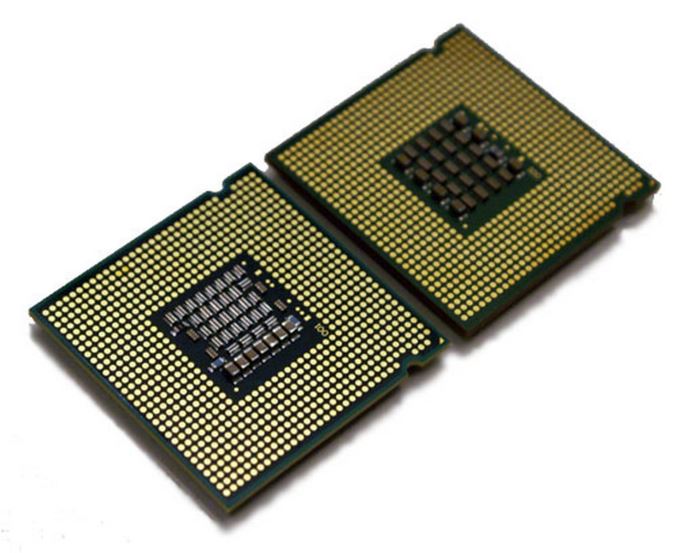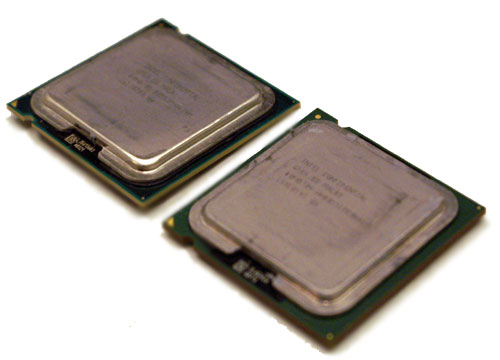Ten Year Anniversary of Core 2 Duo and Conroe: Moore’s Law is Dead, Long Live Moore’s Law
by Ian Cutress on July 27, 2016 10:30 AM EST- Posted in
- CPUs
- Intel
- Core 2 Duo
- Conroe
- ITRS
- Nostalgia
- Time To Upgrade

Today marks a full 10 years since the first Core 2 Duo processors, and hence Intel’s 64-bit Core microarchitecture, were made officially available at retail. These included a number of popular dual-core processor parts, including the seemingly ubiquitous E6400 and the Core 2 Extreme X6800. These were built on Intel’s 65nm process, and marked a turning point in the desktop processor ecosystem. To quote Anand in our launch review: ‘you’re looking at the most impressive piece of silicon the world has ever seen’.
Ten Year Anniversary of Core 2 Duo and Conroe
As part of this piece we will also look at some of the predictions for the future, from the latest (and possibly last) International Technology Roadmap for Semiconductors report, which predicts the stalling of smaller silicon manufacturing nodes over the next 10-15 years.
The first part of this article borrows heavily from Johan’s original look into the Intel Core microarchitecture back in 2006. It’s an awesome read.
Back When I Were A Lad
For a number of our readers, the launch of Conroe was a vast change in the processing landscape. The family of Netburst, Northwood and Prescott processors, in the form of Pentium D and Pentium 4, showed that pursuing the frequency race pushed the silicon far outside its efficiency zone and left a hot, power hungry mess in its wake. It didn’t even come with a muscular V8 sound, and AMD’s Athlon 64 X2 line had taken both the performance and efficiency crown.

Core 2 Duo (left) vs Pentium D (right)
From the perspective of Intel, it had to incorporate a significant paradigm shift in the way it approached the core microarchitecture – no more long pipelines to bump up clock rates to start. The Core microarchitecture design was marketed as a blend of Pentium Pro and Pentium M techniques, as well as the Netburst architecture, however as Johan pointed out at the time, it is significantly Pentium M and it is very hard to find anything Netburst in there. It wasn’t as simple as ‘adding a few functional units or decoders on Yonah and calling it a day’, almost 80% of the architecture and circuit design had to be redone.
As part of this piece, we’re going to take another look at the original architecture improvements of the Core microarchitecture design and some of our old performance metrics from a decade ago.
27th July 2006: Core 2 Launch Day
Ten years ago, Intel launched the following five processors:
| CPU | Clock Speed | L2 Cache |
| Intel Core 2 Extreme X6800 | 2.93GHz | 4MB |
| Intel Core 2 Duo E6700 | 2.66GHz | 4MB |
| Intel Core 2 Duo E6600 | 2.40GHz | 4MB |
| Intel Core 2 Duo E6400 | 2.13GHz | 2MB |
| Intel Core 2 Duo E6300 | 1.86GHz | 2MB |
The X6800 sits at the top with a higher clock speed with a higher supported FSB-to-core ration than previous Intel processors. The Core 2 processors all came from a 143mm2 die, compared the 162mm2 of Pentium D, and they both seem tiny by comparison to the large die sizes we see 2016 for things like the P100. These were chips without integrated graphics either. The introduction of Core 2 pushed the prices of the Pentium D processors down, to give this interesting table:
| CPU | Clock Speed | L2 Cache | Price |
| Intel Core 2 Extreme X6800 | 2.93GHz | 4MB | $999 |
| Intel Core 2 Duo E6700 | 2.66GHz | 4MB | $530 |
| Intel Core 2 Duo E6600 | 2.40GHz | 4MB | $316 |
| Intel Core 2 Duo E6400 | 2.13GHz | 2MB | $224 |
| Intel Core 2 Duo E6300 | 1.86GHz | 2MB | $183 |
| Intel Pentium D 945 | 3.40GHz | 2MBx2 | $163 |
| Intel Pentium D 915 | 2.80GHz | 2MBx2 | $133 |
| Intel Pentium D 820 | 2.80GHz | 1MBx2 | $113 |
| Intel Pentium D 805 | 2.66GHz | 1MBx2 | $93 |
Comparing this to recent Intel processors, and the X8600 matches the list price of the Core i7-5960X (an 8-core part), whereas the popular Core 2 Duo E6400 at $224 at the same price as the Core i5-6600.
A few years ago, I salvaged a super old computer of mine with an E6400 and took it for a spin for a pipeline piece entitled ‘Dragging Core 2 Duo into 2013’. We know that a number of users today are still using the old platform as their day to day machine, and given that it is now celebrating its 10th birthday, it is interesting that anyone wanting to play around with the old hardware can get a motherboard, memory and CPU from eBay for $50-70.
My crusty C2D Setup from 2013











158 Comments
View All Comments
Jon Tseng - Wednesday, July 27, 2016 - link
Great chip. Only just upgraded from my QX6850 last month. Paired with a GTX 970 it was doing just fine running all new games maxed out at 1080p. Amazing for something nearly a decade old!!Negative Decibel - Wednesday, July 27, 2016 - link
my E6600 is still kicking.tarqsharq - Wednesday, July 27, 2016 - link
My dad still uses my old E8400 for his main PC. He's getting my old i7-875k soon though.jjj - Wednesday, July 27, 2016 - link
You can't do DRAM in glasses, not in a real way. Since that's what mobile is by 2025.On-package DRAM is next year or soon not 2025.
You can't have big cores either and you need ridiculous GPUs and extreme efficiency. Parallelism and accelerators, that's where computing needs to go, from mobile to server.
We need 10-20 mm3 chips not 100cm2 boards. New NV memories not DRAM and so on.
Will be interesting to see who goes 3D first with logic on logic and then who goes 3D first as the default in the most advanced process.
At the end of the day, even if the shrinking doesn't stop, 2D just can't offer enough for the next form factor. Much higher efficiency is needed and the size of a planar chip would be far too big to fit in the device while the costs would be mad.Much more is needed. For robots too.The costs and efficiency need to scale and with planar it's at best little.
wumpus - Thursday, August 4, 2016 - link
On package DRAM seems to be a "forever coming" tech. AMD Fury-X basically shipped it, and it went nowhere. I'm guessing it will be used whenever Intel or IBM feel it can be used for serious advantage on some high-core server chip, or possibly when Intel want to build a high-speed DRAM cache (with high-speed-bus) and use 3dXpoint for "main memory".The slow rollout is shocking. I'm guessing nvidia eventually gave up with it and went with tiling (see the Kanter demo on left, but ignore the thread: nothing but fanboys beating their chests).
willis936 - Wednesday, July 27, 2016 - link
I'm certainly no silicon R&D expert but I'm very skeptical of those projections.Mr.Goodcat - Wednesday, July 27, 2016 - link
Typo:"On the later, we get the prediction that 450nm wafers should be in play at around 2021 for DRAM"
450nm wafers would be truly interesting ;-)
wumpus - Thursday, August 4, 2016 - link
I like the rapidly falling static safety. Don't breathe on a 2030 chip.faizoff - Wednesday, July 27, 2016 - link
My first Core 2 Duo was an E4400 that I bought in 2007 I believe, thing lasted me up to 2011 when I upgraded to an i5 2500k. I should've kept that C2D just for nostalgia's sake, I used it intermittently as a plex server and that thing worked great on FreeNAS. The only issue was it was really noisy and would get hot.Notmyusualid - Thursday, July 28, 2016 - link
I've got a few old servers kicking around, all with valid Win server licenses, but due to UK electricity costs, just can't bring myself to have them running at home 24/7 just to serve a backup, or yet another Breaking Bad viewing session... :) which we can do locally now.